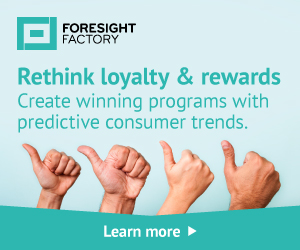Earlier this year we launched our latest Brand Magic study, our analysis of the essence of the most successful brands – and the characteristics that attract consumers to them. When we analysed the data from this research, we came across one extremely surprising trend. It concerned customer loyalty programmes – and it flew in the face of all expectations about the value of these programmes to a brand.
We found that, on average, customer loyalty programmes do not strengthen brands. Instead, they seem to weaken them.
That’s a pretty shocking claim – and so it’s important that I provide some clarification. I’m not saying that customer loyalty programmes don’t work, that they don’t succeed in driving customer loyalty, or that they don’t generate a Return on Investment (ROI). There is plenty of evidence that loyalty programmes achieve all of the objectives that are set for them. However, when you look specifically at the brand impact of loyalty programmes those benefits turn negative. Loyalty programme members are 10% less likely to be strong advocates of the brand than non-members.
Averages can hide a lot, of course. Not all loyalty programmes have a negative impact on brands. However, such a significant inverse correlation as this can’t be ignored. From a brand perspective, there is clearly something wrong with the way many businesses approach loyalty.
Redefining the loyalty experience
The more we interrogated the intersection between loyalty programmes and the strength of a brand, the more we realised that it doesn’t have to be this way. There is absolutely nothing to stop brands creating loyalty programmes that are designed to strengthen brand equity and advocacy alongside the other benefits that they deliver. However, to do so they must move beyond many of the long-running assumptions about what loyalty is for – and what value customers see in it.
The reason that so many loyalty programmes undermine brand strength is that they reduce the brand-customer relationship to a series of transactions. No matter what set of values, emotive positioning or sense of purpose might have drawn a consumer to a brand in the first place; once they become a customer loyalty member, they are invited to value that brand by the quantity and value of the benefits they get. This may succeed in retaining them as customers and retaining them within the loyalty programme, but it tends to erode brand differentiation in the process. The value of the brand relationship becomes the value that is available through the loyalty scheme.
It doesn’t have to be this way. Loyalty programmes can deliver benefits at the same time as extending and enhancing a differentiated brand experience. Those that do, tend to approach customer loyalty in much the same way that they do other areas of the customer journey. They identify the key drivers at different stages of the loyalty experience, and activate against those drivers in a way that reflects the brand’s specific role, purpose and values. This results not only in a more authentic and distinct experience of loyalty – but also an experience that can be delivered more cost-effectively. When loyalty establishes deeper, emotional connections, there’s less requirement to keep raising the ante in terms of the rewards on offer.
A new framework for loyalty planning
To help establish such connections, Foresight Factory has analysed the key needs that people are looking to fulfill at each stage of their journey through loyalty scheme membership. Our loyalty reports explore the key drivers for joining programmes and activating memberships, through to the drivers of more frequent purchases, increased value and customer retention. At each of these key stages of the journey, we pick out significant trends that can be used to plan more relevant and resonant loyalty experiences: millennials’ interest in ‘early bird’ offers that reward membership through a sense of exclusivity for instance, or the audiences most responsive to gamifying the experience of earning and redeeming points. The result is a planning framework from which marketers can identify the trends most relevant to their audiences, and which align most closely with their brand narrative and values.
We don’t believe that the task of retaining customers has to conflict with the task of strengthening a brand. By designing experiences that resonate on an emotive level as well as a transactional one, businesses can achieve both. However, doing so will require them to treat loyalty as part of the overall customer journey with a brand – not just the end of it. We believe that a brand-focused planning framework can help to drive that change. Interested to find out more? You can download a free sample version of our series of reports on customer loyalty today, by clicking here.
